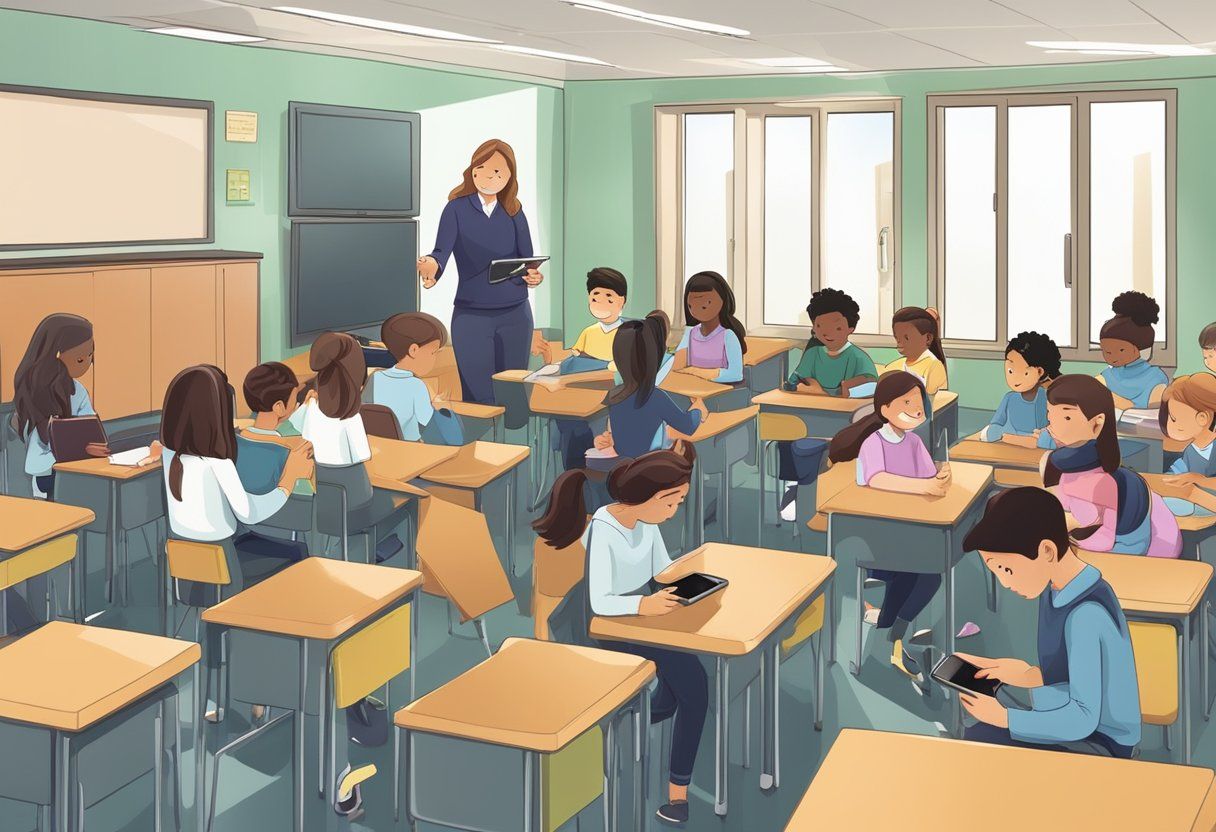Canadian Schools Explore Cellphone Bans, While Some Parents Argue Devices Are Essential Lifelines.
Cell phone use in schools has become a growing concern for educators and parents alike. Students today face challenges with engagement, mental health , and academic performance that many attribute to excessive smartphone usage.
Recent studies out of Spain, Norway and Belgium report that cellphone bans have had a positive effect on academic performance. “Teachers report that kids are much less distracted and the social climate improves."

The impact of cell phones goes beyond just academics. Many teens struggle with social and emotional development as they spend more time on devices and less time interacting face-to-face.
Peer pressure now extends into the digital realm, creating new anxieties for students.
As a result, schools are exploring various approaches to curb phone use and reconnect students with their education and each other.
Key Takeaways
- Cell phone overuse is linked to declining student engagement and academic performance
- Schools are implementing phone bans and other policies to address the issue
- Educators are getting creative with outdoor activities and discussions to re-engage students
Secure Storage Solutions

Schools are exploring new ways to limit phone distractions. Special pouches, lockers, and bins help keep devices out of reach during class time.
A chemistry teacher created a pouch system after seeing too many fights and bullying incidents linked to phones. Many teachers feel powerless to stop in-class phone use.
The pouches lock phones away securely. Only staff can open them with a special key.
Phone restrictions can improve focus and reduce negative social pressures. Without constant access, students may:
- Pay more attention in class
- Interact face-to-face more
- Feel less anxious about missing online activity
- Develop better self-control
Even great lessons can’t compete with the draw of a smartphone. Secured storage gives students a break from the urge to check their devices.
Engaging Beyond Screens
Schools are taking new steps to keep students active and involved after the bell rings. Many are expanding their after-school programs to give kids more options beyond their phones.
Some key initiatives include:
- Creating new clubs for interests like board games and knitting
- Starting neighborhood sports leagues
- Helping students make plans to get involved during back-to-school meetings
The goal is to give every student something fun to do after classes end. This can help kids stay motivated and interested in school.
Peer pressure and social development are big concerns with excessive phone use. Too much screen time can lead to:
• Feeling left out or comparing oneself to others online
• Less face-to-face social interaction
• Anxiety and depression from constant connectivity
• Poor sleep from late-night phone use
• Cyberbullying
By offering more in-person activities, schools hope to improve students’ social and emotional growth.
Interacting face-to-face helps build important skills like:
- Reading body language and facial expressions
- Taking turns in conversation
- Resolving conflicts
- Building empathy
These skills are crucial for healthy relationships and future success.
While some students may still prefer alone time with their devices, having options is key. Even reluctant participants might discover new interests when encouraged to try activities.
Teachers play an important role by guiding students toward engaging options. Morning advisory sessions can introduce clubs and help kids find their niche.
The push for more real-world engagement comes as student motivation has declined . A recent poll found less than half of middle and high schoolers felt motivated to attend school.
By focusing on learning through active participation, schools aim to boost academic success and overall well-being. Balancing technology use with hands-on experiences can help students develop into well-rounded individuals.
Outdoor Activities Boost Student Engagement
Thirteen Maine middle schools tried a new approach to get kids off their phones. They took learning outside for a week in May. Students spent 35,000 hours outdoors during this time.
Being in nature helps kids connect with each other without screens. They did schoolwork, ate lunch, and played outside. Some even camped at night. This got them to:
- Build fires
- Set up tents
- Try new outdoor skills
These activities don’t involve social media or texting. They help kids grow and learn in different ways.
Outdoor time can reduce peer pressure linked to cell phone use. It gives students a break from constant comparisons on social media. This can improve their emotional well-being.
Nature also offers chances for face-to-face talks. These real interactions help kids develop social skills. They learn to read body language and facial expressions better.
Teachers can adapt their lessons for outside . This keeps students interested and focused on learning, not on their phones.
Parental Role in Cell Phone Culture
Parents and guardians play a crucial part in shaping their children’s cell phone habits. Some educators suggest limiting device use during social gatherings at home. This helps kids focus on face-to-face interactions.
It’s important for parents to avoid texting their children during school hours.
Constant check-ins can cause anxiety and distract from learning. Giving kids space to be independent at school is valuable for their growth.
Cell phones can affect social and emotional development:
- Peer pressure to stay constantly connected
- Reduced in-person social skills
- Anxiety from fear of missing out
Parents can set a good example by putting away their own phones during family time. This shows children the value of undivided attention in relationships.
Combating digital isolation
Social media and smartphones have changed how teens interact. Many students feel hesitant to speak up in class. They worry their words might spread quickly through messaging apps or online platforms.
This fear of being judged or excluded makes some teens very quiet during discussions. Even when talking about books or neutral topics, students may stay silent. They don’t want to risk saying something that could be seen as controversial.
To address this, some teachers use anonymous online discussion tools. These allow students to share thoughts without fear.
While costly, these platforms can increase engagement significantly.
Peer pressure takes on new forms in the digital age. Cyberbullying through apps like TikTok and Snapchat can harm teens’ social and emotional growth.
The constant connectivity of phones makes it hard to escape negative interactions.
Vaping is another issue amplified by social media. Teens may feel pressure to try it after seeing posts glorifying the activity. This highlights how online influences can impact real-world behaviors.
The effects go beyond the classroom. Many teens struggle with:
- Lower self-esteem
- Increased anxiety
- Trouble forming in-person connections
- Sleep issues from late-night phone use
- Decreased empathy
Experts suggest setting phone-free times and encouraging face-to-face talks.
Parents and schools can help by modeling healthy tech habits. Teaching digital literacy is key to navigating online spaces safely.
While phones offer benefits, balance is crucial.
Helping teens develop strong social skills and emotional resilience offline is vital.
This can equip them to handle digital pressures and foster meaningful relationships.
Cell Phone Impact on Student Well-being
Cell phone use in schools can affect students’ social and emotional growth. Peer pressure to stay connected may lead to anxiety. Some kids feel left out if they don’t have the latest devices.
Constant notifications can disrupt focus and learning.
Experts worry about:
- Reduced face-to-face interactions
- Cyberbullying risks
- Sleep disruption from nighttime use
- Addiction to social media and games
Common Questions About School Cell Phone Policies
Why are schools limiting phone use?
Schools limit phone use to help students focus. Phones can distract from learning. They also cause social issues. Some key reasons include:
- Improving attention in class
- Reducing cheating on tests
- Limiting cyberbullying
- Encouraging face-to-face interaction
How do phone rules affect students?
Phone rules can change how students act and learn. Some effects are:
- Better grades and test scores
- More participation in class
- Less disruption during lessons
- Improved social skills
- Lower anxiety levels
Are there legal issues with phone rules?
Phone rules can raise some legal questions. Schools must balance student rights and safety. Key points:
- Students have some privacy rights
- Emergency contact must be allowed
- Rules should be clear and fair
- Enforcement should be consistent
How do schools enforce phone limits?
Schools use different methods to limit phones. Common approaches:
- Phones stored in lockers
- Collection at start of class
- Warnings then confiscation
- Parent involvement for repeat issues
- Tech-free zones in school
How do phone limits affect student wellbeing?
Phone limits can impact student health and safety. Both good and bad effects are seen:
| Positive Effects | Negative Effects |
|---|---|
| Less social media stress | Harder to contact parents |
| More in-person friendships | Anxiety from being “unplugged” |
| Improved sleep habits | Loss of learning apps |
| Reduced eye strain | Safety concerns in emergencies |
Do phone rules differ in other places?
Phone policies vary widely. Different areas take different approaches:
- Total bans in some countries
- Partial restrictions in others
- School-by-school choices in some places
- Age-based rules in certain regions
- Tech-positive policies in some schools
How do phones affect social growth?
Phones can impact how students develop socially and emotionally:
- Less practice with face-to-face talks
- FOMO (fear of missing out) from social media
- Cyberbullying concerns
- Pressure to always be available
- Reduced empathy from less in-person interaction
Building better solutions for better business®




